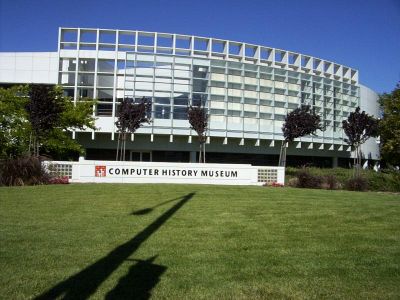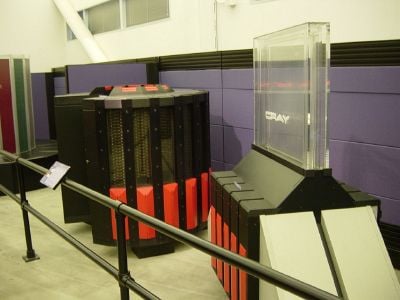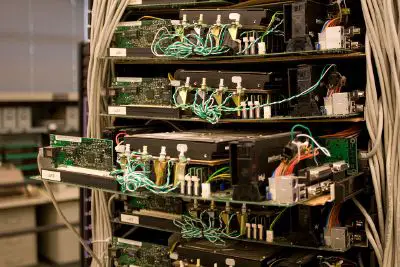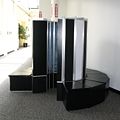Computer museum
A computer museum is a museum devoted to the preservation, education, and study of computers. Computer museums often hold historic mainframe super computers as well as abacuses and other historic computing devices. Such displays and collections which include information about inventors and their inventions help visitors to understand today's computer technology in a broader historical context.
Some computer museums are part of science museums, while some are independent museums. The Computer History Museum in Silicon Valley, California, is the largest computer museum in the world.
Overview
Computer museums focus on computer hardware, software, and notable inventors and inventions. Because of rapid changes in computer technology, even the latest developments soon become obsolete and disappear from the market. Computer museums preserve each step of this rapid development and treat the development of computer technology as part of cultural heritage. Computer museums often hold historic mainframe supercomputers as well as home computers. Institutions or organizations often donate rather than discard these super computers.
Computer museums often present computers in their social and historical contexts and display historic computing devices such as abacuses computing machines.
Some computer museums exist within a larger institution, such as the Science Museum in London and the Deutsches Museum in Munich. Others, such as the Computer History Museum in Mountain View, California, the Heinz Nixdorf Museum in Paderborn, and The National Museum of Computing at Bletchley Park, are dedicated specifically to computing. Some specialize in the early history of computing, others in the era that started with the first personal computers such as the Apple I and Altair 8800, Apple IIs, older Apple Macintoshes, Commodore Internationals, Amigas, IBM PCs, and more rare computers such as the Osborne 1. Some concentrate more on research and conservation, while others focus more on education and entertainment.
There are also some private collections. Microsoft has their own computer museum at their headquarters which is open to the public, and at one time Apple Computer also had a museum open to the public.
Bletchley Park conserves and exhibits equipment associated with British code-breaking activities during the Second World War.
The UK National Archive for the History of Computing in Manchester, England concentrates on the preservation of historical documents related to computing, rather than on the computers themselves.
Other collections exist only in online form. There is an extensive hardware collection at old-computers.com,[1] first opened online in 1996. Collections of software and documentation also exist online, for example at Bitsavers.[2]
Computer history museum (U.S.)
History
The Computer History Museum is a museum established in 1996 in Mountain View, California, when The Computer Museum (TCM, in Boston) sent the majority of its historical collection to Moffett Field, California, so that TCM could concentrate on computing-related exhibits for children. Thus, it was originally the West Coast division of The Computer Museum, named The Computer Museum History Center until it shortened its name in 2001, when it focused on the preservation and presentation of the stories and artifacts of the information age, and further the computing revolution and its effect.
Originally located at Moffett Field in an old building that was previously the Naval Base furniture store, the museum acquired its current building (previously occupied by Silicon Graphics), in Mountain View, California, U.S. (Silicon Valley), in October 2002. It opened there to the public in June 2003.
Former media executive John Hollar was appointed CEO of The Computer History Museum in July 2008.
Collections
The Computer History Museum[3] is home to the largest and most significant collection of computing artifacts in the world. This includes many rare or one-of-a-kind objects such as a Cray-1 supercomputer (The Cray-1 was a supercomputer designed by a team including Seymour Cray for Cray Research. The first Cray-1 system was installed at Los Alamos National Laboratory in 1976, and it went on to become one of the best known and most successful supercomputers in history) as well as a Cray-2, Cray-3, and, on request, Cray-4 parts, the Utah teapot, the 1969 Neiman Marcus Kitchen Computer, Hewitt Crane's all-magnetic computer, an Apple I, an example of the first generation of Google's racks of custom-designed web servers, and the first coin-operated video game. The collection comprises of nearly 50,000 objects, photographs and films, as well as 4,000 feet (1,200 m) of cataloged documentation and several hundred gigabytes of software.
Other photographs from the Computer History Museum
The National Museum of Computing (U.K.)
The National Museum of Computing is a museum in the United Kingdom dedicated to collecting and restoring historic computer systems. The museum is based at Bletchley Park in Buckinghamshire, and opened on July 12 2007. It is fully open to the public on Thursdays and Saturdays. Access to the museum is free to paying visitors to Bletchley Park.
On display in the museum are many famous early computing era machines, including the Colossus computer, a machine that helped break German encryption during World War II.[4] The Colossus rebuild project is open to visitors seven days a week.
The museum includes iconic machines from the 1960s such as the Elliott 803 and 905, an ICL 2966 mainframe from the 1980s, a wide range of analogue computers, a hands-on retrocomputing room, a gaming room, and several restoration projects such as the PDP-8 and the PDP-11-based air traffic control system from London Terminal Control Centre at West Drayton near London.
The museum is managed by the CodesandCiphers Heritage Trust,[5] a registered charity. The title The National Museum of Computing is an operating name.
The initial cost of opening the museum was around £250,000. Fundraising continues, and the museum has received donations from PGP Corporation,[6] IBM, and HP.
American Computer Museum
The American Computer Museum is a museum of the history of computing located in Bozeman, Montana. It was founded in May 1990, by Barbara and George Keremedjiev as a non-profit organization. The museum was originally intended to have been located in Princeton, New Jersey, but the location was changed when the founders moved to Bozeman. It is likely the oldest extant museum dedicated to the history of computers in the world. The Computer Museum in Boston opened first, but it closed in 1999.
A partial list of computer museums
- Bletchley Park in Bletchley, England
- DigiBarn Computer Museum in Boulder Creek, California
- Rhode Island Computer Museum
- The Computer Museum, Boston, closed in 1999
- Personal Computer Museum in Brantford, Ontario, Canada
- Heinz Nixdorf Museum in Paderborn, Germany (also claims to be the largest)
- The Centre for Computing History in Haverhill, Suffolk, UK Computer Museum
See also
Notes
- ↑ Homepage Old-Computers.com. Retrieved July 16, 2022.
- ↑ Software Archive Bit Savers. Retrieved July 16, 2022.
- ↑ Computer History Museum. Retrieved July 16, 2022.
- ↑ UK computer history gets new home BBC, July 11, 2007. Retrieved July 16, 2022.
- ↑ The National Museum of Computing Retrieved July 16, 2022.
- ↑ Bletchley receives £57,000. BBC, September 9, 2008. Retrieved July 16, 2022.
ReferencesISBN links support NWE through referral fees
- Computer Museum History Center. The Computer Museum History Center. Mountain View, CA: Computer Museum History Center, 1990.
- Digital Computer Museum. Digital Computer Museum Report. Marlboro, MA: The Museum, 1982.
- Museum Computer Network. Museum Computer Network, Inc. Stony Brook, NY: Dept. of Computer Science, State University of New York, 1984.
- Pescovitz, David. "Modern Art—The Computer Museum History Center Is a Past-Forward Tour Through Hardcore Hardware. The Ghosts in These Machines Keep Moving—Fast." Wired. 7 (11) (1999): 276.
- Ryder, Eric Otto. A Prototypical Computer Museum. Thesis (M. Arch.)—University of South Florida, 1999.
- Wallich, P. "The Ghosts of Computers Past Landmark Computer Hardware and Software Have Found a Home Near an Old Blimp Hangar at Moffett Federal Airfield's Computer History Museum." IEEE SPECTRUM. 39 (2002): 38-43.
- Williams, M. R. "The Computer History Museum." SIGCSE BULLETIN. 35 (2003): 12.
- Zhang, Qingqing. A Design for Computer Museum on Campus. Thesis (M.Arch.)—Iowa State University, 2005.
External links
All links retrieved January 7, 2024.
- The Computer History Museum
- Heinz Nixdorf MuseumsForum
- The National Museum of Computing
- The Centre for Computing History UK Computer Museum
- American Computer & Robotics Museum
Credits
New World Encyclopedia writers and editors rewrote and completed the Wikipedia article in accordance with New World Encyclopedia standards. This article abides by terms of the Creative Commons CC-by-sa 3.0 License (CC-by-sa), which may be used and disseminated with proper attribution. Credit is due under the terms of this license that can reference both the New World Encyclopedia contributors and the selfless volunteer contributors of the Wikimedia Foundation. To cite this article click here for a list of acceptable citing formats.The history of earlier contributions by wikipedians is accessible to researchers here:
- Computer_museum history
- Computer_History_Museum history
- The_National_Museum_of_Computing history
- American_Computer_Museum history
- Cray-1 history
The history of this article since it was imported to New World Encyclopedia:
Note: Some restrictions may apply to use of individual images which are separately licensed.







